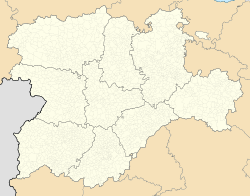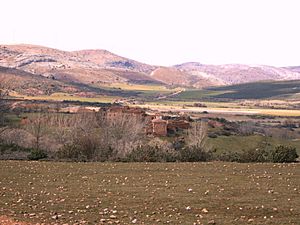Montejo de Tiermes facts for kids
Quick facts for kids
Montejo de Tiermes
|
|||
|---|---|---|---|

View of Montejo de Tiermes
|
|||
|
|||
| Country | |||
| Autonomous community | |||
| Province | |||
| Legal district | Partido judicial de El Burgo de Osma | ||
| Area | |||
| • Total | 167 km2 (64 sq mi) | ||
| Elevation | 1,157 m (3,796 ft) | ||
| Population
(2018)
|
|||
| • Total | 153 | ||
| • Density | 0.916/km2 (2.373/sq mi) | ||
| Time zone | UTC+1 (CET) | ||
| • Summer (DST) | UTC+2 (CEST) | ||
Montejo de Tiermes is a small town in the province of Soria, Spain. It is part of the Castile and León region. In 2010, about 198 people lived in the whole area (municipality), and 58 people lived in the main town itself.
Contents
The Ancient City of Tiermes
Just a short drive from Montejo de Tiermes, you can find the amazing Tiermes archaeological site. This ancient place is one of the most important and surprising Roman sites in Spain. In the 1930s, a Spanish archaeologist named Blas Taracena called Tiermes "the Spanish Pompeii." This shows how special and well-preserved it is, much like the famous Roman city of Pompeii.
Next to the ancient ruins, there is a beautiful old church called the Romanesque chapel of Santa María. This church shows that people have lived in this area for a very long time, even after the Roman city was no longer active.
Nature and Local Life
The area around Montejo de Tiermes has a changing landscape. You'll see red earth and fields that turn green or brown depending on the season. This creates a colorful pattern throughout the year.
The Pedro River and the Montejo stream flow through these lands, providing water. Another stream, Pozo Moreno, runs near the village. All these streams eventually join the larger Duero River.
Montejo de Tiermes is located between the Ribera and El Burgo areas, close to the Castile-La Mancha region. The municipality includes several smaller villages, each with its own interesting natural and cultural spots.
Exploring Montejo Village
Montejo village has stone houses built along what used to be its main street. If you walk along this street, you will find a lovely church dedicated to Saints Cornelius and Cyprian. It has a Renaissance-style entrance and a Romanesque porch with four arches.
Inside the village, there is an old dovecote. This building reminds us that raising livestock and farming were, and still are, important activities for the people of Montejo.
Ancient Art in Caves
In one of the villages near Montejo, called Sotillos de Caracena, you can find ancient cave art. These drawings were made after the Stone Age. They show human-like figures, plant shapes, nets, circles, and other geometric designs.
The Old Holm Oak Tree
A bit to the east of Montejo, in Valderromán, there is a forest of holm oak trees. One of these trees is very old and large. People say it is more than 800 years old! Its trunk is about 5 meters (16 feet) around, and its shade covers an area larger than 300 square meters (3,200 square feet).
Important Historical Places
Several places in the Montejo de Tiermes area are protected as important cultural sites:
- Romanesque Hermitage of Nuestra Señora de Tiermes: This old church was recognized as a monument in 1982.
- Church of San Juan Bautista: Located in Ligos, this church became a monument in 1995.
- Hermitage of the Virgen del Val: Found in Pedro, this hermitage was listed as a monument in 2000.
- Tiermes archaeological site: This ancient city was declared an archaeological site in 1999.
A Glimpse into History
Montejo de Tiermes has a long and varied history. You can see a Roman fountain at the entrance of the town. There's also an old watchtower in one of the central streets, which was built by Muslims and might be from the time of the Reconquest.
We don't know the exact beginning of Montejo de Tiermes. However, we know from the buildings and the nearby Tiermes site that many different groups lived here. These include the Arevacos, Celtiberians, Romans, Visigoths, and Arabs. After being retaken by Christians, it was even a stopping point for the famous Spanish hero, El Cid, on his journey into exile.
Over time, parts of the area that is now Montejo de Tiermes belonged to different communities. For example, some parts were in the Community of Villa y Tierra de Ayllón, and others were in the Community of Villa y Tierra de Caracena.
In the 1800s, after some changes in how Spain was organized, Montejo became part of the Soria province. The municipality also grew to include more villages over the years.
Local Economy
The main ways people make a living in Montejo de Tiermes are through farming and raising animals. Farmers grow crops like wheat, barley, and oats. Raising sheep is also an important activity.
Tourism is also growing in the area. Many people visit because of the ancient Celtiberian-Roman ruins of Tiermes and the museum next to them.
A special event called the Astronomy Days (AstroTiermes) brings many people to the area each year. Around three hundred amateur and professional astronomers gather near the Tiermes site. They come to enjoy the clear night skies, which is a type of tourism known as astro-tourism.
Images for kids
See also
 In Spanish: Montejo de Tiermes para niños
In Spanish: Montejo de Tiermes para niños






